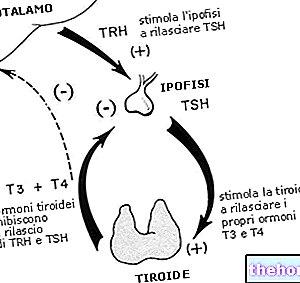Generality
Myxedema is a particular form of subcutaneous edema, which arises as a result of the accumulation of mucopolysaccharides in the dermis.
The main cause of myxedema is severe hypothyroidism, ie the condition in which the thyroid is unable to synthesize an amount of thyroid hormones adequate to the needs of the human body.

Image from wikipedia.org
The presence of myxedema is characterized by various symptoms and signs, including: exophthalmos, swelling of the legs, thickening of the skin, recurrent fatigue, dry skin, mood changes, muscle cramps, decreased sexual desire, hypertension, bradycardia, etc.
Failure to treat myxedema can have unpleasant consequences, ranging from hypothermia and slowed breathing to lack of response and coma (myxedematous coma).
A physical examination, anamnesis, blood tests and some specific laboratory tests are essential for a diagnosis of myxedema.
An accurate diagnosis allows to identify the precise triggering causes. Knowing the cause is essential for planning the most appropriate treatment.
The prognosis depends on the curability of the causes and the timeliness of diagnosis.

What is myxedema?
Myxedema is a subcutaneous edema, typical of severe hypothyroidism and some forms of hyperthyroidism, which arises as a result of an accumulation of mucopolysaccharides in the dermis.
OTHER USES OF THE TERM MIXEDEMA
In the medical field, the term myxedema also represents a synonym for severe hypothyroidism.
This is due to the high frequency of occurrence of myxedema in people with severe hypothyroidism.
ORIGIN OF THE NAME
The word "myxedema" derives from the "union of two Greek terms, which are:"myxa” (μύξα) And "oidema” (οἴδημα). The term "myxa" means "mucus" or "slimy substance", while the term "oidema" means "swelling". Hence, the literal meaning of "myxedema" is "mucus swelling" or "mucous swelling".
EPIDEMIOLOGY
Among people with hypothyroidism, myxedema is more common in those who do not follow adequate therapy, in women and in the elderly.
Causes
The main cause of myxedema is hypothyroidism.
However, myxedema can also appear as a result of some forms of hyperthyroidism, such as the so-called Graves' disease.
According to some statistical surveys, about 5 out of 100 people with Graves' disease (therefore 5%) develop myxedema.
WHAT IS HYPOTHYROIDISM?
Doctors speak of hypothyroidism, when the thyroid gland is unable to synthesize an amount of thyroid hormones adequate to the needs of the whole organism. In other words, those suffering from hypothyroidism have an underproductive thyroid.
There are at least 4 different forms of hypothyroidism: primary hypothyroidism, secondary hypothyroidism, tertiary hypothyroidism and iatrogenic hypothyroidism.
- Primary hypothyroidism. It means that hypothyroidism derives from a specific thyroid dysfunction. The main causes of primary hypothyroidism are: autoimmune diseases of the thyroid gland (eg: Hashimoto's thyroiditis), iodine deficiency following a diet poor in this mineral and partial removal or total thyroid gland (for example, to treat a thyroid tumor).
- Secondary hypothyroidism. All hypothyroidisms following a malfunction of the pituitary and the pituitary hormone system (TSH) are secondary
Pituitary neoplasms (pituitary adenomas) or lesions affecting the pituitary structure (post-traumatic lesions, post-aneurysm, post-radiotherapy, etc.) may cause a malfunction of the pituitary gland.
- Tertiary hypothyroidism. All hyperthyroidisms following a malfunction of the hypothalamus and the hypothalamic hormonal system (TRH) are tertiary.
Hypothalamic neoplasms or lesions of the hypothalamic structure can cause malfunctioning of the hypothalamus. - Iatrogenic hypothyroidism. It is hypothyroidism due to incorrect medical treatment. In general, iatrogenic hypothyroidism arises from excessive doses of antithyroid drugs, administered to treat hyperthyroidism.

WHAT IS HYPERTIROIDISM?
Although hyperthyroidism is a remote cause of myxedema, it is good to review briefly what it is.
Doctors speak of hyperthyroidism when the thyroid gland produces more thyroid hormones than the body needs. In other words, people with hyperthyroidism have a thyroid that synthesizes more thyroid hormones than it would actually need.
As with hypothyroidism, there are at least 4 different forms of hyperthyroidism: primary hyperthyroidism, secondary hyperthyroidism, tertiary hyperthyroidism and iatrogenic hyperthyroidism.
- Primary hyperthyroidism. It means that hyperthyroidism depends on a specific thyroid dysfunction. An example of primary hyperthyroidism is Graves' disease, also known as Basedow's disease.
- Secondary hyperthyroidism. Hyperthyroidism arising from an overproduction of TSH by the pituitary gland is secondary. In general, the overproduction of TSH by the pituitary is a typical consequence of pituitary tumors.
- Tertiary hyperthyroidism. Hyperthyroidisms dependent on "hyperproduction of TRH by the" hypothalamus are tertiary.
- Iatrogenic hyperthyroidism. It is hyperthyroidism due to incorrect medical treatment. Generally, iatrogenic hyperthyroidism occurs due to excessive doses of thyroid hormones, administered to treat hypothyroidism.
RISK FACTORS OF MIXEDEMA
Risk factors for myxedema include: a medical history of hypothyroidism, female gender, old age, surgical removal of the thyroid and the presence of autoimmune diseases.
Symptoms, signs and complications
The characteristic clinical sign of myxedema is swelling where the accumulation of mucopolysaccharides has taken place.
The anatomical sites in which the appearance of myxedema is more frequent are the anterior portion of the legs and the eyes.
Myxedema located in the front of the legs leads to a condition that doctors refer to as pretibial myxedema.
Myxedema based in the eye, on the other hand, results in a condition known as exophthalmos.
What is exophthalmos?
The exophthalmos is the pathological protrusion of one or both eyeballs towards the outside of their relative orbits.
The presence of exophthalmos is generally associated with endocrine diseases.
HYPOTHYROIDISM AND MIXEDEMA
An individual with severe hypothyroidism and myxedema experiences several symptoms and signs, including:
- Thickening of the skin;
- Recurrent fatigue;
- Weight gain
- Changes in mood;
- Dry skin;
- Brittle hair
- Hair thinning
- Changes in sexual regularity (in women);
- Decreased sexual desire
- Muscle cramps
- Pain in the bones and muscles;
- Hypertension;
- Bradycardia;
- Slowing of the word.
COMPLICATIONS
Failure to treat myxedema and what causes it (usually hypothyroidism) can lead to several complications - including slowed breathing, chest pain, low body temperature, hypoglycemia or lack of response - leading to the coma (myxedematous coma).
Myxedematous coma represents a serious loss of brain function and requires immediate medical attention, as the life of the affected person is in serious danger.





























